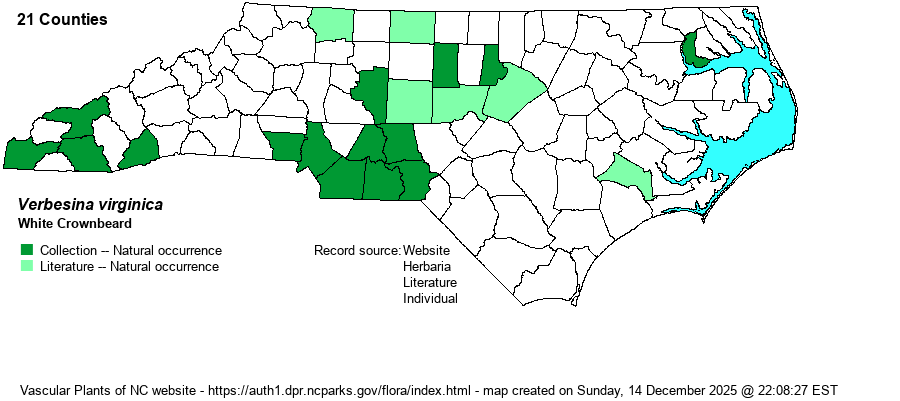| Author | L. | |
| Distribution | Southern Mountains, central and eastern Piedmont, and outer Coastal Plain. Large gaps exist; some of those areas will likely be filled with additional field work.
Southeastern VA to eastern KS, south to northern FL and TX. Interestingly, there are numerous records from southeastern VA, yet there are hardly any NC Coastal Plain records. | |
| Abundance | Despite the number of county records, this species is seldom encountered, and there are relatively few SERNEC specimens despite its obvious stature and identification. (One of the editors -- LeGrand -- conducted a Piedmont Mafic survey in the mid-1990s and never saw the species, despite coverage in all counties where specimens have been reported.) Rare in the southern Piedmont, but very rare to rare in the southern Mountains and the northern half of the Piedmont. Extremely rare in the Coastal Plain (two records). This is a Watch List species, though the status should be moved from W7 to W1, as the species is not overlooked or poorly surveyed. | |
| Habitat | Openings in mesic to dry woodlands and forests, clearcuts, powerlines, roadsides, stream borders -- but strictly over mafic/calcareous rocks. It is an obligate species of high pH soils in the region. | |
| Phenology | Flowering and fruiting July - early October. | |
| Identification | White Crownbeard is a robust herb that grows to 6 or 7 feet tall, with alternate, stalked, elliptical leaves that are taper-pointed and that have short, dull teeth (crenate). Stems are pubescent throughout. The inflorescence is open, with clusters of heads at the ends of branches; rays are broad, relatively short, and white, while disks are dull grayish. The hairy stem and not sharply toothed leaves will separate it from V. alternifolia when neither is in flower. Despite its occurrence being reported from at least 21 counties, this is a quite scarce species in the state, with few biologists being familiar with it. Thankfully, it is much more common in states to our south and west. | |
| Taxonomic Comments | The only certain variety in the state is the nominate one. A second variety, laciniata, occurs along the Atlantic Coast. Its leaves are 3-5 lobed. There are no known records for NC, but is to be looked for. Most references lump it.
| |
| Other Common Name(s) | Common Frostweed, Frostweed | |
| State Rank | S2? [S2] | |
| Global Rank | G5? | |
| State Status | [W7] | |
| US Status | | |
| USACE-agcp | FACU link |
| USACE-emp | UPL link |

